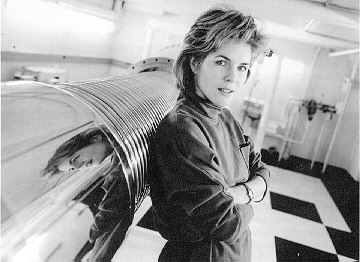
NUCLEAR SAFETY and TECHNOLOGY
MIT Energy Laboratory
 |
Current Research:
NUCLEAR SAFETY and TECHNOLOGY MIT Energy Laboratory |
Work in this area has led to new and improved technologies as well as novel methodologies for understanding and managing power plant operations and maintenance. Continuing projects have produced better analytical methods for characterizing nuclear reaction processes inside various types of reactors, especially prior to and during transients. Included are three-dimensional models that can determine time-dependent power distributions in the core of a light water reactor with reasonable accuracy. Such models make possible improvements in both design and operation.
A major source of problems in nuclear plants is corrosion in heat transfer equipment, which can lead to leaks, emergency shutdowns, and costly repairs. Researchers have designed, built, and operated loops that simulate coolant systems in light water reactors. The loops are being used in the MIT research reactor to study how water chemistry affects corrosion and how radiolysis products form and move around inside the cooling system. Other investigators have developed methods of calculating corrosion in heat-transfer pipes and have formulated simple and convenient models that operators can use to predict which pipes in a plant are prone to damage and what procedure will best deal with the problem.
A large-scale international program on enhanced nuclear power plant safety and performance led to creation of new methodologies that will promote safe operation of existing nuclear power plants. The Energy Laboratory-led program involved people from throughout the international nuclear community. One outcome of the program has been an innovative system for the electromechanical monitoring of motor-operated valves, which are prevalent in nuclear reactors. The system involves instrumentation and models to predict component behavior and to detect incipient faults based on patterns of measured vibrations. Researchers have also developed new techniques using pulsed acoustic waves for the non-destructive, non-invasive detection of the internal condition of apparatus such as piping in nuclear plants.
Recently the Laboratory's work has broadened from strictly technical problems to the management, political, and social issues that now play a critical role in the fate of nuclear power worldwide. One focus is on understanding and improving plant maintenance and operations to ensure the safe performance of aging plants. Researchers use system dynamics methods to understand how technical, social, and political factors interact and how those interactions affect plant operation, performance, and safety. The system dynamics approach is also now being applied to the tasks involved in managing and operating nuclear waste facilities.

A new and expanding area of Energy Laboratory research is nuclear medicine. One advanced method of curing brain and other cancers is boron neutron capture therapy, in which boron is deposited into the cancerous tissues and subsequently activated by a stream of neutrons to produce therapeutic effects. Energy Laboratory researchers are participating in work to develop a commercially viable system for producing an optimum neutron beam at the treatment position. Other work aims to apply boron neutron capture therapy to treat rheumatoid arthritis, a chronic disease of the joint that affects 1-3% of the adult US population. Researchers are developing an optimized boron-containing compound for delivery to the affected joint, a moderator assembly capable of producing a neutron beam optimized for joints of different sizes, and an accelerator-beam line-and-gantry system that will allow complete flexibility for joint irradiation. The completed system will provide a safe, non-invasive approach to treating rheumatoid arthritis that will involve substantially less pain than traditional surgery and elimination of the usual three-month rehabilitation time.

 the Energy
Laboratory Home Page.
the Energy
Laboratory Home Page.